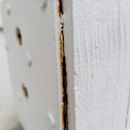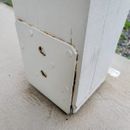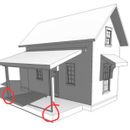Post base corrosion
Hello,
I built a small house for myself about 5 years ago. I have a porch attached to the side of the house supported by two 6×6 pressure treated columns. The other day I happened to notice some corrosion on the Simpson ABU connectors at the base of the columns. It doesn’t appear to be an immediate concern but from what I understand about rust, it’s only a matter of time before the connector is eaten up. I checked the Simpson website to learn more about corrosion between pressure treated wood and their Z-Max connectors, but they couldn’t give me advice on how to remediate the situation. The base of the columns are exposed to wind-driven rain, and I think that’s exacerbating the situation.
I looked at my structural plans and noticed there’s a pad footing underneath each column (cast as a monolithic pour with the porch slab), so I can’t just add new columns next to the old ones and then remove the old ones as I need that pad footing to bear the weight of the porch roof. I’m thinking I could ask my engineer for a temporary framing plan to brace the beam above while I remove and replace the columns and ABU’s, but then I’m wondering how invasive it is to remove an ABU (can’t drill out the old anchor?). Does anyone have an experience in this area or general thoughts on a good strategy to mitigate?
GBA Detail Library
A collection of one thousand construction details organized by climate and house part












Replies
You can have two mechanisms at work here causing corrosion of those connectors: chemical reactions between the materials, and galvanic action, which is an electrical process between dissimilar materials acting like a battery.
The usual way to deal with the chemical issue is to use the proper fasteners. Code allows the triple coated fasteners in treated wood, but I prefer to just use stainless and not worry about the integrity of the coatings. You can use “interface” materials too, such as a thin plastic or stainless steel sheet between the connector and the treated wood post.
The last step is to paint the assembly rod weather protection using a durable paint. Keep in mind that many paints won’t adhere well to galvanized metal such as the surface of the Simpson connectors.
Bill
Thanks Bill. My framer used the connector and wood member specified from my structural engineering. I think it's the wind driven rain that is accelerating the corrosion (catalyzing the galvanic action and chemical reactions). I think I'll just reach out to the engineer to ask about a methodology for repair/replacement.
My guess is the building was built at the time the chemistry of pressure treated lumber had just changed and before the new hardware was the only stuff in the shelves.
Yes, it was supposed to be compatible as ordered. As I recall they changed the hardware a few times after the new wood came out.
I don’t see it a critical problem at this point. When the time come to change it, my guess is the engineer will say slab is strong enough to support the roof shown in the drawing.
Walta
Thanks Walta. I went ahead and reached out to the engineer for advice.
espositodesign_joel,
The dead loads on that roof are pretty small. A 4"x4" wedged in about 6" away from the existing one so it is still on the thickened area odf slab would do.
If the pressure treated lumber in your area is still ACQ, isolate the post saddle with a piece of peel & stick membrane.